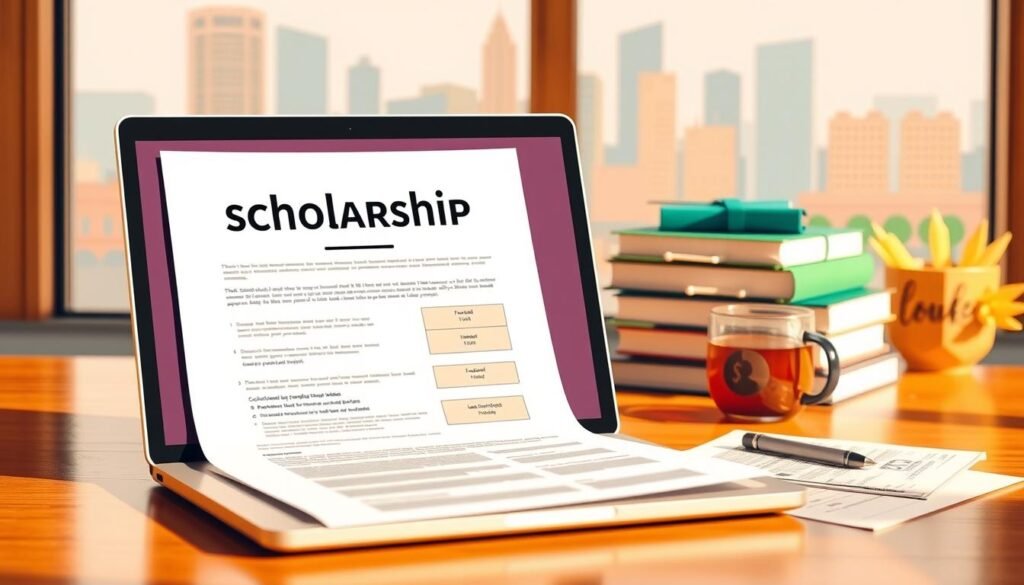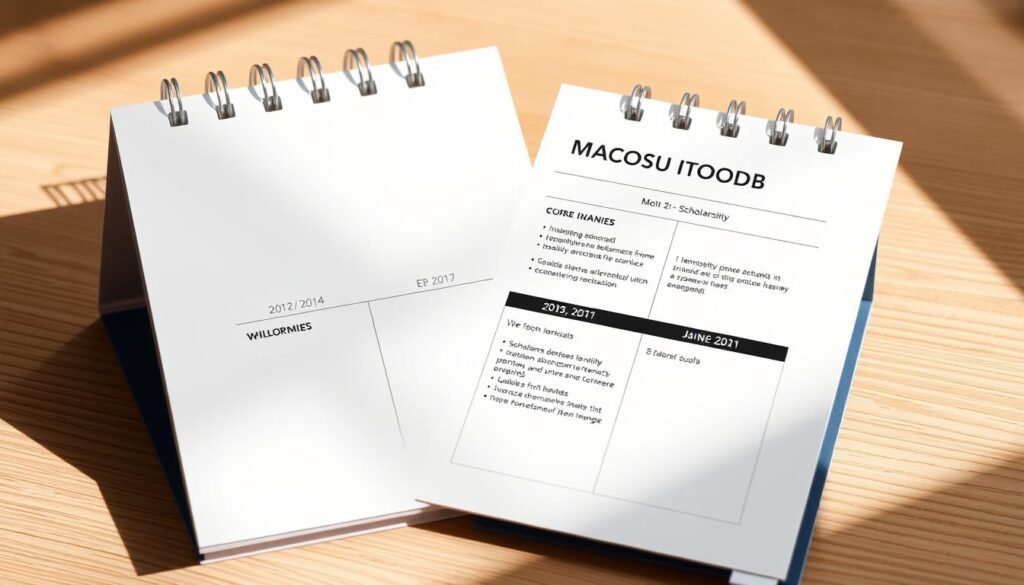
Learn How to Apply Online Scholarships Step by Step USA

You might feel the weight of tuition bills and the worry of unanswered financial questions. That tension is real, and it changes how you plan for college. You are not alone in this.
When you chase a scholarship, you look for clear, practical help that saves time and reduces loan pressure. This guide gives you a friendly roadmap to a stronger scholarship application and better financial aid choices.
Start early, collect documents, and target awards that match your profile. If you are in high school or already a college student, small daily efforts add up.
There are many scholarships out there. With a simple system, you will find plenty of chances that fit your GPA and goals. Use calendars, organize transcripts, and keep a reusable toolkit of essays and letters.
By following a clear plan you save time and increase your chances. This introduction sets the tone so you can move forward with confidence and focus.
- What you’ll learn today about scholarship applications and financial aid
- Start early so deadlines, essays, and recommendations don’t overwhelm you
- Define your scholarship profile to match the right opportunities
- Smart scholarship search strategies that actually work
- Understand requirements before you apply scholarships online
- Documents checklist to streamline every application
- Transcripts and test scores: what scholarships require and how to submit
- Letters of recommendation that highlight your best work
- Write essays that win: from brainstorming to final polish
- apply online scholarships step by step USA: organize, complete, and submit
- Follow up, track notifications, and apply for many scholarships
- Your next steps to boost your chances this year
What you’ll learn today about scholarship applications and financial aid
You’ll get clear information on the scholarship application process and how financial aid can lower college costs. This section shows which parts of an application matter most and which awards fit your profile.

You’ll learn to match your strengths to award types: merit, need-based, athletic, identity, and field-specific options. You’ll also use multi-channel search tools like Fastweb, Scholarships.com, and College Board, plus school counselors and local groups.
"Small, steady work and organized files beat last-minute scrambling."
- Key components: eligibility, essays, recommendations, and transcripts.
- Practical criteria: GPA around 3.0–3.5+ and above-average SAT/ACT help for many awards.
- How to track deadlines, follow up, and combine local awards with larger options.
By the end, you’ll have a simple checklist and a flexible plan that keeps you moving without burnout. Use this info to find plenty of opportunities and make each new application faster and stronger.
Start early so deadlines, essays, and recommendations don’t overwhelm you
Start your timeline now so deadlines won’t catch you off guard. Early planning gives you margin for edits, letters, and tech glitches. Many awards have early or seasonal deadlines, while others run year-round.
Create a year-round scholarship calendar with buffer time
Build a calendar and work backward. Map major portals and dates, then schedule drafting, editing, and submission days. Give recommenders at least 7–10 days and allow extra time for transcripts.

- Map each month with key portals and deadlines, then set drafting and review days.
- Block 7–10 days as buffer for letters, transcripts, and final edits.
- Separate year-round opportunities from seasonal cycles tied to the academic year.
- Set weekly micro-goals refine one essay or update a resume item to keep steady progress.
- Batch uploads and formatting tasks, and use reminders plus counselor check-ins for accountability.
"Submitting ahead of time saves you from last-minute errors and portal outages."
Keep a rolling 60–90 day list and reflect after each submission to improve your next application. For high school lists and targeted help, check this high school scholarships page and this undergraduate guide for timelines and tips.
Define your scholarship profile to match the right opportunities
Create a brief snapshot of who you are and what you offer. This helps you quickly see which awards fit your record and goals. A clear profile saves time and focuses your search on high-match opportunities.

Know the main award types
Scholarships span many types: merit for high GPA or test scores, need-based tied to financial documents, athletic, identity-based, religious, community service, field-specific (STEM, arts, health), military, and niche or quirky awards.
Inventory your strengths
- List academics, gpa trends, and test results.
- Note leadership roles, hours of community work, and awards.
- Record projects, positions, and any special talents or certifications.
- Align your college or career goals with field-specific support.
"Concrete proof beats vague claims track events, hours, and outcomes."
Pick 3–5 core themes that tell one clear story. Use short positioning blurbs for each theme you can reuse in essays and letters. This makes each application faster and stronger and helps you prioritize which scholarships to pursue first for the best fit-to-effort return on your application.
Smart scholarship search strategies that actually work
A focused search plan turns scattered leads into real award chances. Use a mix of national tools, school resources, and local networks so you cover both high-visibility and low-competition options.
Start with trusted engines: create free profiles on Fastweb, Scholarships.com, and College Board’s Scholarship Search. Filter results by GPA, major, and background to get matched opportunities and save top choices to a dashboard.
- Scan college financial aid pages for institutional awards tied to admissions or departments.
- Ask your counselor for a local list community groups, businesses, religious and veteran organizations often have fewer applicants.
- Check employer and brand programs used by your family; many offer annual student awards.
Verify every lead confirm contact info, past winners, and never pay fees. Build a shortlist that blends national reach with local odds, track eligibility notes, and run weekly searches so new postings don’t slip past you.
"A small, steady search habit outperforms last-minute scrambles."
Understand requirements before you apply scholarships online
Knowing what each award asks for cuts wasted time and raises your odds of success. Read eligibility notes first so you focus on realistic matches for your profile.
Eligibility signals often include minimum gpa (commonly 3.0–3.5+), class rank (top 10–20%), and baseline test scores (around SAT 1028 / ACT 19.5). Field-specific awards will ask for proof of major, a portfolio, or documented contributions. Identity or state programs may require residency or demographic documentation.
Financial need and documentation
Need-based awards commonly request FAFSA data, tax returns, or asset details. Pull your FAFSA Submission Summary and recent income info early to avoid delays.
Submission formats to watch
Applications accept essays, videos, MP3 audio, PDFs, social posts with exact hashtags, or interviews. Check file size limits, video length, and naming rules. A few awards still need mailed packets—prepare signatures, envelopes, and postage when required.
"A quick preflight checklist prevents last-minute disqualifications."
- Confirm gpa, test, and class-rank signals before you start an application.
- Have field-of-study proof and demographic documents ready.
- Verify file types, hashtag wording, and interview steps in your tracker.
Tip: Keep a short preflight checklist for each scholarship application and save time. For additional information and tools, visit this scholarship resources page.
Documents checklist to streamline every application
A tidy document plan makes every application faster and more reliable. Gather common materials up front so you can focus on essays and letters when time is tight.
What to collect: transcripts (official or unofficial), test scores if required, a current resume, and solid letters of recommendation. Need-based awards often ask for FAFSA summaries, tax records, or other proof of financial need.
Core file groups to keep ready
- Create a master Scholarship Application folder with subfolders for transcripts, scores, resume, letters, essays, and ID.
- Request official transcripts or download unofficial ones and save with clear file names and dates.
- Keep your resume updated with impact metrics hours, results, leadership so attachments are ready anytime.
Final checks and safety
Line up recommendation writers early and save signed PDFs or submission notes per award. Tailor personal statements to each prompt while reusing strong stories to save time.
"Never share bank or credit card numbers; treat such requests as likely scams."
Tip: Add a one-page checklist to each subfolder so you never miss a required field, upload, or signature. Collect IDs and acceptance letters when requested and verify organizations before you send sensitive documents.
Transcripts and test scores: what scholarships require and how to submit
Transcripts and score reports are the paper trail that proves your academic record to award panels. Treat them as core parts of each scholarship application and plan ahead for delivery time.
Official vs. unofficial transcripts and where to request them
Merit awards often need transcripts to confirm your GPA, course rigor, and honors. High school students request records from the school counselor or main office. College students order transcripts from the registrar.
Some programs accept unofficial PDFs; others insist on sealed or electronically verified files. Check each application’s submission method upload, mail, or e-delivery and request official copies early.
Using SAT/ACT strategically even at test-optional colleges
Even if a college is test-optional, a strong SAT or ACT can boost merit consideration. Decide whether to include test reports based on your scores and the award’s focus.
- Confirm official vs. unofficial needs and request records early.
- Verify how your GPA appears (weighted or unweighted) and check the transcript for errors.
- Store PDFs, keep sealed copies if required, and log when each file was sent.
"Plan timelines for transcripts and score reports so processing doesn’t delay your submission."
Letters of recommendation that highlight your best work
A powerful letter of support tells a clear story about your work and impact in school or the community. Strong letters reinforce your scholarship narrative and show selection committees the person behind your grades.
Choose teachers, supervisors, or community leaders who know you well
Pick recommenders who saw your best work. Teachers, coaches, supervisors, and community leaders who watched you lead or solve problems create vivid, memorable notes.
Mix academic and community voices so committees see your range. A teacher can confirm classroom strength while a mentor highlights initiative outside school.
Ask early, provide a brag sheet, and give clear deadlines
Request letters well before the due date and follow up with a short email that includes your resume or brag sheet, the prompt, and submission instructions.
- Select recommenders who can cite specific examples of your work and results.
- Give clear deadlines and clarify direct submission versus attachments.
- Stagger requests so no one person is overloaded and you cover multiple strengths.
- Set a polite one-week reminder and store copies when allowed.
"Specific examples beat generic praise concrete stories help your application stand out."
Thank recommenders promptly and update them on outcomes. Good relationships yield better letters and open future opportunities for students seeking further scholarship support.
Write essays that win: from brainstorming to final polish
A winning essay connects a short personal story to the sponsor’s mission and shows real impact. Start by reading the prompt carefully and underlining the exact question. This keeps your response focused and compliant with word limits.
Answer the prompt, show your story, and align with the mission
Dissect the prompt to find criteria and the mission you must address. Pick one clear story that shows challenge, action, and impact. Use concrete results hours, awards, outcomes to prove your claims.
Edit, proofread, and tailor reuse smartly without going generic
Proofread on two different days and ask at least two people to review, including one teacher or mentor who can speak to leadership or work you’ve done. Reuse paragraphs from your bank, but tailor each draft so it fits the sponsor’s mission.
- Keep to word counts and follow formatting rules.
- Align the essay with your recommendation and resume so the application tells one cohesive story.
- Save final drafts with clear file names and version notes.
"Clarity and honest detail beat vague lists."
For extra tips on structure and voice, see Emerson College essay guidance. This helps students polish tone and tighten conclusions that connect goals to education and future colleges.
apply online scholarships step by step USA: organize, complete, and submit
Set up a master filing system to manage multiple applications without chaos. A tidy hub saves you hours and keeps details from slipping through the cracks.
Build a master folder with subfolders for each application
Create one main folder for this cycle and add subfolders per award. Inside each, keep transcripts, letters recommendation, essays, and a one-page index of eligibility and requirements.
Rename files clearly so uploads are fast and error-free.
Double-check formats, attachments, and submission portals
Verify file types, exact addresses or portals, and any social media hashtags or interview steps. Most entries use online forms, but some still need mailed packets confirm before you send.
"Submit early save a screenshot or confirmation email and log the date in your tracker."
- Match names and addresses to your ID.
- Use a pre-submission checklist for every application.
- Submit at least 48 hours before the deadline to leave room for fixes.
Follow up, track notifications, and apply for many scholarships
Keep a tight follow-up routine so no notification or deadline slips through the cracks. A clear tracker turns scattered tasks into steady progress and reduces last-minute panic.
Create a tracker with columns for name, deadline, submitted date, notification date, status, and renewal conditions. Use a spreadsheet or a simple table so you can sort by deadline or amount.
Log award amounts, stackability rules, and whether funds are one-time or renewable. Note gpa targets for renewables and set annual FAFSA reminders for need-based aid.
Create a tracker for deadlines, statuses, and results
- Record submitted dates and follow-up reminders.
- Tag items by fit and effort so you can batch quick applications during busy weeks.
- Schedule weekly checks for pending results and extra document requests.
Prioritize local and smaller awards while aiming for renewables
Local community and organizational opportunities often have better odds and add up. Meet with your counselor regularly to find new leads and protect tuition funding with steady, smart volume each year.
"Persistence and organized follow-up improve your chances more than sporadic effort."
Your next steps to boost your chances this year
A short, focused plan this week can change how much aid you earn this year. Start a year-long calendar with target windows and buffer days. Set up profiles on Fastweb, Scholarships.com, and College Board to gather steady leads.
Build a master folder and tracker now. Request transcripts and line up letters so they’re ready before your first deadline. Draft two core essays and tailor them to match mission prompts.
Balance local, renewable, and field-specific awards. Keep submitting across the year and hold weekly review sessions. This steady work helps reduce college tuition and grows your scholarship options while you invest in your education.
If you want to know other articles similar to Learn How to Apply Online Scholarships Step by Step USA you can visit the category Scholarships.






Leave a Reply